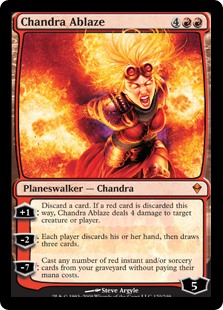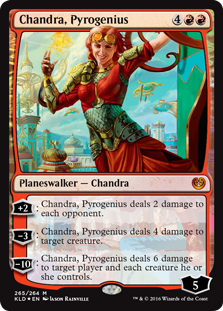Although there is much to love about the fantasy genre, the overt sexualisation of female characters is still an issue today. However, it is reassuring to know that games such as Magic: The Gathering strive for equal and appropriate representation. Those who have been burnt by the fire of Chandra are already well aware that she continues to be a shining role model, as well as a really, and I mean really, powerful character.
The phenomenon of Magic: The Gathering was created by Wizards of the Coast back in 1993 and has grown to become perhaps the most successful table-top trading card game in history as well as making it big in the video game scene. The latest expansion, Aether Revolt, continues to add complexity to this constantly expanding strategy game.

So what makes Magic so successful? A large and very loyal fan base. Dedicated Magic players spend hours of their lives (and a small fortune) collecting and upgrading card sets based on each new expansion. The rarity and real world monetary value of certain cards attracts collectors and new features keep players battling year after year.
Each game you play depicts a magic battle against Planewalkers, wizards of this mythical realm who each have a complex story-line that forms the basis of every new Magic edition or expansion. These story-lines found within Magic: The Gathering seek to break the stereotypes and misogyny found in all too many games.
“I can say that I feel a personal responsibility to provide characters that everyone can aspire to – especially those left malnourished by two thousand years of western literature largely written by and for white cishet men.”
“I can say that I feel a personal responsibility to provide characters that everyone can aspire to – especially those left malnourished by two thousand years of western literature largely written by and for white cishet men.” – Chris L’Etoile, Narrative Design Coordinator at Wizards of the Coast and part of Creative R&D since 2016.
Chandra is one such Planeswalker who first came onto the scene in 2007. She is a child of inventors and possesses power over flame (pyromancy). Chandra is about overwhelming power and destruction. To play a Mountain Chandra-themed deck is to play with fire. Not your typical female fantasy stereotype. Being one of the principal creative writers for Magic: The Gathering, L’Etoile has been responsible for much of Chandra’s story in the newest narrative arcs.
“I can say that I write every character from within their skin and behind their eyes.” L’Etoile states. “Character is not appearance, not biology or costume. Character is nervous habits, the childhood memory that rushes back at an unexpected scent, the moment they reach out to another but can’t quite bring themselves to touch. It’s what they think while waiting for sleep. I can say that I endeavour to show the full breadth of humanity in my work. I don’t always succeed. Everything is a work in progress.”

In Aether Revolt, the story begins with Tezzeret’s corrupted Consultate confiscating inventions and imprisoning inventors in Kaladesh with their fostering of such activities all a ruse. Chandra leads the revolt against the Consulate and in the process learns more about her past (see Aether Revolt Episode 05: Burn).
What is truly remarkable about this fiery engineer is that since conception she has been represented as an intelligent and powerful character escaping the trope of the sexualised female in the fantasy genre.
“I’m fortunate to possess an ability and a platform that allow me to show others a better world. I take that responsibility seriously. Chandra is wiry anxieties and scattered starling thoughts, wrapped around an empathy so profound it makes her fingers quiver. To borrow a line from Jose Molina, ‘She feels everything, she can’t not.’ If others find her a kindred soul, I’m glad for it.”
And so are we.
Check out how Chandra has evolved over the years below, with her descriptions focusing upon her power, genius and defiance. Can you think of a better role model?













